Infrared panels nearby windows, will the infrared rays pass through them or not?
Posted by Marcel van der Steen in Explanation 1 Comment» Infrared panels are offered more and more as a cheaper (and more comfortable) alternative, compared to central heating, to create an adequate inner climate in your house and rooms. I understand very well the theoretical functioning of these panels and how to create a pleasant in-house climate. However recently have have run into two companies, that sell a lot of infrared panels, telling me that the infrared rays coming from infrared panels do travel straight trough windows, and even that their infrared panel manufacturers do tell them that. This is nonsense to me, and in this article I explain that infrared radiation coming from infrared panels do not travel straight through windows. I will explain that heat (energy) can travel through windows (easier than through walls) but that is a different process.
Infrared panels are offered more and more as a cheaper (and more comfortable) alternative, compared to central heating, to create an adequate inner climate in your house and rooms. I understand very well the theoretical functioning of these panels and how to create a pleasant in-house climate. However recently have have run into two companies, that sell a lot of infrared panels, telling me that the infrared rays coming from infrared panels do travel straight trough windows, and even that their infrared panel manufacturers do tell them that. This is nonsense to me, and in this article I explain that infrared radiation coming from infrared panels do not travel straight through windows. I will explain that heat (energy) can travel through windows (easier than through walls) but that is a different process.
Infrared panels
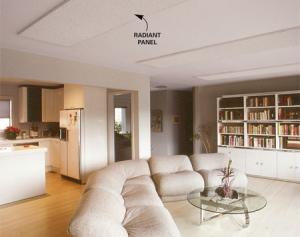 Infrared panels are panels that, in most cases, are connected to the grid voltage and then heat up to about 90 deg C which make them generate infrared radiation. If a human moves in this beam of rays the heat is immediately felt. It is a pleasant heat, comparable by just sitting in the sun.
Infrared panels are panels that, in most cases, are connected to the grid voltage and then heat up to about 90 deg C which make them generate infrared radiation. If a human moves in this beam of rays the heat is immediately felt. It is a pleasant heat, comparable by just sitting in the sun.
There are panels taht heat up to about 90 deg C and also panels that go much higher, for instance to about 350 deg C. There are even spirals that heat up until they emit reddish light, meaning the spiral gets up to 1500 deg C, but these are not considered here.
The panels that heat up to about 90 deg C, can be use din normal rooms against walls or ceilings to about 2.5 – 3 m height. Panels that work at 350 deg C are used for spaces with high ceilings (4 m and higher) or in work halls or high attics. These latter panels are too hot to be occasionally touched with bare hands.
The radiation coming from 90 degrees panels is called long wavelength infrared radiation and that from 350 degrees panels short wavelength infrared radiation. Of course, the wavelength of the radiation coming frm a heat source of 350 deg is shorter than those emitted from a 90 deg panel, however compared to infrared radiation coming from the aforementioned spiral or the sun, then the infrared radiation from the panels is all considered to be long wave(length). It is important to note this as we will see that long wave infrared radiation will not travel trough windows.
Infrared radiation travel through windows, or not?
At OliNo we make use of an infrared camera with which we make infrared pictures, and every pixel of these images represent a temperature of that item that the pixel in the image represents.
I used an 75 W halogen lamp to have a heat source available for this test. I have let it warm up and then positioned about 1 m distant to my double glaze window in my living room.
Here a picture (with an infrared picture inserted) that shows the 75W halogen light bulb seen sideways. It heats up to about 80 deg C, it is positioned at 1 m distance from a double glaze window in my living room (the double glazing dates from 1983, which is not as isolating as the the HR++ nowadays). Measuring the temperature at the front side of the lamp gives the follwing result.
The light bulb has a maximum temperature of about 151 deg C. It is much more than that of a 90 deg infrared panel, however for the purpose of this test this works well. I will now go outside and make an infrared picture of the window to see whether we can see this light bulb. If infrared rays do travel straight through the windon then I would be able to see this light source in an infrared image. The distance of 1 m to the window is somewhat worst case, as infrared panels will be at least this distance away from windows, most likely further away in many applications.
We are now outside and I first present a normal image. In the image there is a rectangle with the maximum temperature point indicated, being 15.5 deg C. However it is outside the light beam coming from the heat source (light bulb)!! Measured temperature right at the spot on the window where the light of the light bulb i spassing through is only 12 deg C! Let us look at the infrared image.
Look at the result. I myself am visible as a reflection in the window and the highest temperature measured in the rectangle is at the position of my hand. A window reflects about 10 % of the environment and for the other 90 percent it radiates its own temperature. As a window’s surface is very homogene and flat, it is possible also with oly 10 % reflection, to see myself clearly as a reflection in the window.
It is clear that the infrared rays coming from the 75 W halogen lamp are not at all passing straight through the window. We simply do not see any heat spot coming from the light bulb, in our infrared image!
What now follows is a theoretical explanation of the reason why (long wave) infrared radiation does not pass through regular windows. After this explanation I will do a small experiment showing that heat can travel through a window and I will show how that process works.
Transmittance of standard glass and the infrared radiation of a 90 and 350 deg C infrared panel
We can explain theoretically why standard glass is not transparent to long wave infrared radiation, and that radiation from both 90 and 350 deg C panels, is considered to be long wave in this perspective.
I looked for the property of glass that explains the transparency of glass for infrared radiation. It is called the tranmittance, which is very high for regular light (as we can see through glass, where the value of transmittance is about 1). We also know that UV radiation is not very well transmitted through windows which means that, when we sit behind glass, we do not get sun burned neither do we get a tan.
The standard glass that is most used for glazing is called soda-lime silica glass. Its transmittance is given here.
So here given the transmittance of clear soda-lime glass. The wavelengths are shows from 300 nm to 4500 nm, and we are interested in the infrared region of wavelengths meaning from 800 nm and higher. The graph shows that the transmittance drops dramatically to 0, beyond 2700 nm.
Now it is important to know the energy radiated from the infrared panels at 90 and 350 deg C, and compare this to the transmittance that belongs to the windows we use in houses.
The radiation coming from an infrared panel can be determined by observing the radiation of a black body radiator. A black body radiator is an element that very efficiently radiates energy, and a regularly available infrared panel operates close to that of an hypothetical black body device. The equation that describes the amount of energy radiated from a black body radiation, at every wavelength, is given here:
 (source Wiki).
(source Wiki).
The parameter T represens the absolute temperature, which is 363 K for a 90 deg C panel and 623 K for a 350 deg C panel. We can now create a graph of te energy emitted by these panels as function of wavelegth.
In this graph we see three lines. Black dashed is the transmittance of sodo-lime glass. Then two lines indicating the energy emitted as function of wavelength, for a 350 deg C and a 90 deg C infrared panel.
We determine the part of the energy that travels through the glass via transmission, as follows: we multiply, for each wavelength, the transmittance value with the energy radiation curve. We sum up these resulting values and compare that to the bare sum of all values of the energy radiation curve alone. The results are shown: only 4.3 % of all radiation within 0 – 20,000 nm of a 350 deg C panel travels via transmission through a standard glass, ad only 0.2 % of a 90 deg C panel. Again:
Only 0.2 % of infrared radiation of a 90 deg C infrared panel travels as radiation through a standard window glass!
Only 4.3 % of infrared radiation of a 350 deg C infrared panel travels as radiation through a standard window glass!
This is negligible! Double glass will let through even less (long wave) infrared radiation.
But windows are known to generate loss of energy?
A normal window glass loses more energy per square meter considering a certain temperature difference between inside and outside, than a wall does. The way the energy, coming from infrared radiation, passes through a window or a wall is as follows: the window and the wall are, from their part facing the inner space in the house, heated up by absorbing the infrared radiation (a wall absorbs about 95 % and a windown about 85 – 90 %). Once heated up from one side (the inner-house side), it will heat up the inner parts of the window and wall, heating up towards the side facing outside-house. So finally the window as well as a wall has itself heated up until it reaches the outer side facing outside. A window is thinner than a wall so will be heated up quicker than a wall will. And once the wall or window has its outside locally heated up, it will there radiate energy to the outside environment.
I did an example as follows; by placing the halogen light bulb very close to the window (10 cm distance).
We see in the right hand side the light bulb and its hottest part is about 100 deg C. Then the glass in the middle that shows a maximum temperature of 31 deg C. And in area 3 we see the reflection of the light bulb, resulting in a temperature of maximally 43 deg C. About 85 % – 90 % of this 43 deg C value comes from the window’s own surface temperature and 10 – 15 % of the light bulb temperature. The latter was about 150 deg C as we know from an earlier measurement, so 10 – 15 % of this is 15 – 23 deg C. This means that the real surface temperature of the window is then 43 – 15 to 23 deg C meaning 28 – 20 deg C. This can be realistic for a sheet of window relatively close to the 75W halogen light bulb.
We go outside and see what results of it.
Nice isn’t it? The window partly has been heated up and passed the absorbed energy through it until it reaches outside. The hottest spot in the rectangle is about 18 deg C and the coolest spot 12 deg C. So much much lower than the light source itself however there is heat lost via absorption and transport through glass and not via direct passing of infrared rays through glass.
To make this last statement more evident, I have put the light source again at 1 m distance and much higher. See next image.
The hotspot is below, temperatures maximallly 17 deg C and minimum 11 deg C. See now the normal image where the light source is positioned.
The heat source is further away and further up. So that what we see in the infrared image is the heated up local part of the window, still emitting its energy from the time that the light source (or heat source) was positioned very closely to it. So again, the infrared rays coming from the light/heat source are not straightly traveling through glass, but the prcoess of heat transfer is one of absorption and then conduction towards the outer side to the outside.
The heat source being again at 1 m distance, its effect is not measureable in the window.
Conclusion
An infrared panel of 90 or 350 deg C will not loose its infrared radiation directly through a window. The process of loss of energy is much slower and works via absorption, heating up and heat transfer via conduction trough the glass material until it reaches the part facing outside, where it radiates energy away. When the window is of a better insulating type, such as HR++, then the heat loss will be lower.
How to heat with infrared panels in a conservatory?
The statement of the companies was that a conservatory cannot well be heated using infrared panels. This is not true. The heat loss trough windows can be higher than through walls, but when good insulating double glaze windows are used and maybe some more panel power needs to be installed, also conservatories can be heated up this way. (Virtually) No radiation is lost directly through the windows!
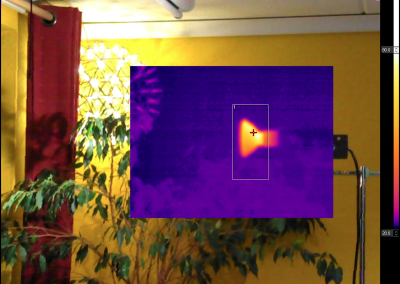
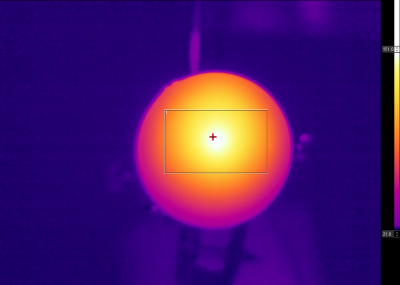
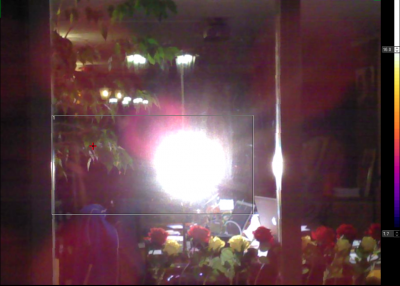
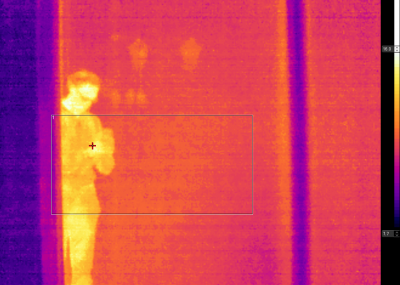
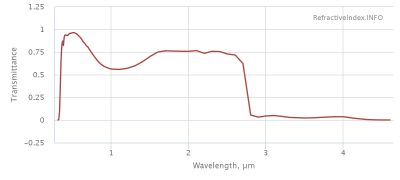
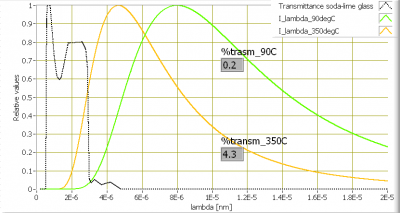
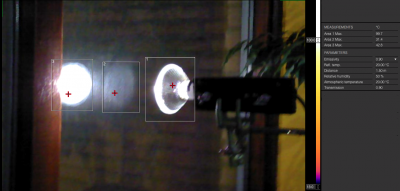
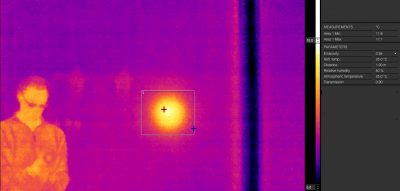
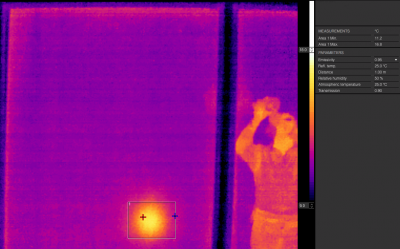
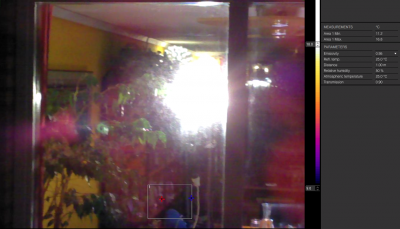





1 reply on “Infrared panels nearby windows, will the infrared rays pass through them or not?”
Interesting. An improvement to this situation could he brought about by finding a way to reflect the IR back from the inside surface of the glass, so that heat t is not absorbed and conducted out. I’m trying to find an affordable material for this, for two large windows in a house that cannot be double glazed. 3M do make some materials, but they are mostly intended for reflecting sunlight and heat from the outside of office block windows. The search continues!